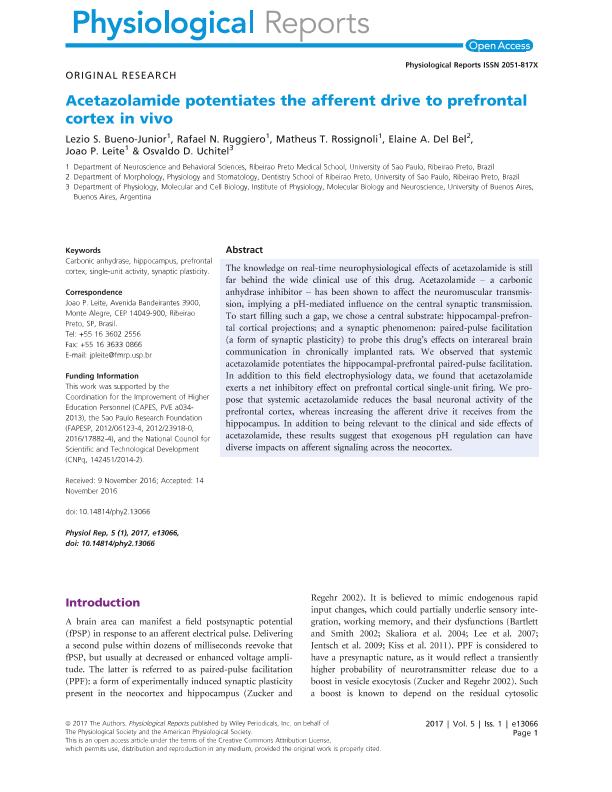Artículo
Acetazolamide potentiates the afferent drive to prefrontal cortex in vivo
Bueno Junior, Lezio; Ruggiero, Rafael N.; Rossignoli, Matheus T.; Del Bel, Elaine A.; Leite, Joao; Uchitel, Osvaldo Daniel

Fecha de publicación:
05/01/2017
Editorial:
American Physiological Society
Revista:
Physiological Reports
ISSN:
2051-817X
Idioma:
Inglés
Tipo de recurso:
Artículo publicado
Clasificación temática:
Resumen
The knowledge on real-time neurophysiological effects of acetazolamide is still far behind the wide clinical use of this drug. Acetazolamide – a carbonic anhydrase inhibitor – has been shown to affect the neuromuscular transmission, implying a pH-mediated influence on the central synaptic transmission. To start filling such a gap, we chose a central substrate: hippocampal-prefrontal cortical projections; and a synaptic phenomenon: paired-pulse facilitation (a form of synaptic plasticity) to probe this drug's effects on interareal brain communication in chronically implanted rats. We observed that systemic acetazolamide potentiates the hippocampal-prefrontal paired-pulse facilitation. In addition to this field electrophysiology data, we found that acetazolamide exerts a net inhibitory effect on prefrontal cortical single-unit firing. We propose that systemic acetazolamide reduces the basal neuronal activity of the prefrontal cortex, whereas increasing the afferent drive it receives from the hippocampus. In addition to being relevant to the clinical and side effects of acetazolamide, these results suggest that exogenous pH regulation can have diverse impacts on afferent signaling across the neocortex.
Archivos asociados
Licencia
Identificadores
Colecciones
Articulos(IFIBYNE)
Articulos de INST.DE FISIOL., BIOL.MOLECULAR Y NEUROCIENCIAS
Articulos de INST.DE FISIOL., BIOL.MOLECULAR Y NEUROCIENCIAS
Citación
Bueno Junior, Lezio; Ruggiero, Rafael N.; Rossignoli, Matheus T.; Del Bel, Elaine A.; Leite, Joao; et al.; Acetazolamide potentiates the afferent drive to prefrontal cortex in vivo; American Physiological Society; Physiological Reports; 5; 1; 5-1-2017; 1-7
Compartir
Altmétricas



